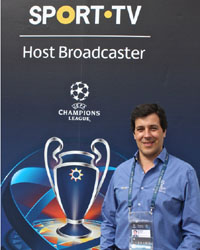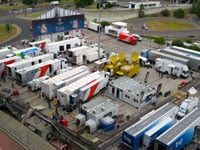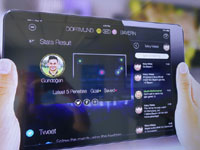Search the latest and greatest job opportunities in sport

Saturday night’s Champions League final between Real Madrid at Club Atlético de Madrid in Lisbon, Portugal proved to be compelling football for fans around the world and it was up to a national broadcaster, this time Portugal’s Sport TV, to make sure the TV production lived up to those global expectations.
Alvaro Cabral, host broadcast project leader for the final and a team of more than 220 worked hard (and some extra-long hours courtesy of the overtime) to make sure that not only did the core production of the match meet a high standard but that more than 20 broadcasters on site also had their unilateral needs met with respect to studio positions, pitch-side commentary, individual camera needs, and more.
The presence of the broadcasters inside the stadium during the match included 16 pitch side positions as well as four pitch-view studios and nine tribune platforms.
“We started preparation in September and from then until now there have been huge hours invested into the layout of the compound, camera plans, the mixed zone, the flash area, and more,” said Cabral hours prior to the match. “And during a regular Champions League match here we may have four or five visiting broadcasters but here there are more than 20 so the scale is much larger,” adds Cabral. “There are also up to 80 trucks in the compound.”

A football match may seem to be something that can be produced with only a few cameras but matches at the top level can often require more than 25 cameras. For Saturday’s final more than 33 cameras were in use as well as a helicopter shot, a Spidercam for aerial shots inside the stadium, two ultra slo-mo units, various minicams, goalcams, and another camera capturing an external beauty shot. There was also commentary in three languages for the Dolby audio signal: Portugese, Spanish, and English.
Cabral says the experience of playing host broadcaster was like getting a master’s degree in a few months.
“I can’t say in one word what the experience is like but it’s a new world with tons and tons of information,” he adds.
This year’s Champions League Final also provided a great showcase for next-generation broadcast and second-screen services that might be offered by UEFA. With new rights deals beginning at the end of 2015 it’s time for the association to get feedback from rights holders on the potential for things like 4K and improved second-screen applications.
The demonstration area, located in the TV compound, gave rights holders a chance to see 4K coverage of the final as well as play with a potential new second-screen service that would deliver three or four live camera angles, multi-angle clips of match highlights within seconds of events occurring, synchronized play-by-play data, and team tracking data to tablets, phones, and computers so that fans can have a timely second-screen experience.
The trick, says Olivier Gaches, UEFA Digital Media Solutions Manager, will be to make sure the first and second screen experiences are in sync regardless of whether the viewer is watching the event live or they pause the TV and then start it at a later time. The solution, he says, is to use audio watermarking that triggers events on the second screen based on the audio of the first screen.
“A real second-screen experience needs a way to synchronise both the first and second screen and audio today is quite proven [as a way to synchronise] content,” says Olivier Gaches.
The way the technology works is the broadcast signal is passed through a device that inserts a time stamp into the broadcast signal’s audio track. When the viewer is watching the event on the TV, whether live or recorded and played back later, the second-screen app begins and ends certain events (replay, games, stats) based on the audio track in the broadcast.

The Champions League Final also gave UEFA a chance to showcase 4K and Ultra HD, courtesy of a closed-circuit production that made use of Telegenic’s T25 OB and its four Sony F55 4K cameras coupled with Fuji prime cinema lenses.
“We’ve learned that there is no difference between HD and 4K which is brilliant for the production teams as there is no difference in how they work,” says Eamonn Curtin, Telegenic, commercial manager.
There are, however, some modifications made to the production as the goal was to give Champions League rights holders a chance to evaluate pure 4K images in the production compound. The use of true 4K cine lenses is one such modification and there will also be no DVE moves or wipes.
“We kept it clean and simple to showcase the wow factor of 4K images on the 90-inch Sony 4K screen [in the UEFA Digital Media Showcase area],” adds Curtin. “It’s a true 4K workflow all the way through.”
The four cameras were placed at the traditional camera one and two positions near the center of the pitch as well as an additional camera to the left and right of those for behind-the-goal coverage. The limitation to four cameras was partially driven by the fact that the Telegenic OB unit only has four cameras.
“We could have gone for more cameras and we will be for productions later in the year but these are our own systems,” says Curtin. “And what’s been proven is that you can sit on the camera one shot because it’s one hell of a shot and you don’t mind staying on it.”
In a little more than two weeks another international football event will take to the global stage: the World Cup. Telegenic will be there as well, providing support for 4K broadcasts of three matches from Rio.
“Our four 4K cameras and lenses will be used for another job next week and then head straight to the World Cup,” explains Curtin. Globosat will provide four 4K cameras with Fuji Cabrio lenses and then Sony will provide an additional four to bring the complement up to 12 cameras.
“I think that we will get there with regards to having one truck that can do a 4K shoot and then have a dual output of HD, similar to what we’ve done for 3D where we take the left eye,” adds Curtin. “There are still some challenges with lenses and depth of field but the manufacturers are getting there.”
Photo 1: Alvaro Cabral oversaw the host TV production of the Champions League Final on Saturday night.
Photo 2: A synchronised second-screen experience will help keep fans more focused and tuned in with the main broadcast.
Photo 3: The TV compound at the Champions League Final featured OB vehicles and broadcasters from all around Europe and beyond.
The Technology in Sport Series - In association with SVG Europe .
Search the latest and greatest job opportunities in sport